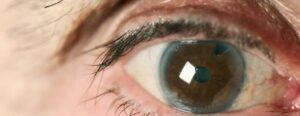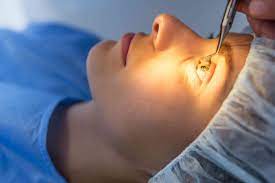If you have been told that you have a blue dot cataract, you may wonder what this means. A blue dot cataract is a type of cataract caused by the lens of the eye becoming cloudy. This can lead to blurry vision and difficulty seeing colors correctly. This blog post will discuss the symptoms, causes, and treatment options for blue dot cataracts.
What Are Blue Dot Cataracts?
 Blue dot cataracts are a type of congenital cataract that is characterized by a small, round, white, or blue dot in the center of the pupil. They are caused by abnormalities in the development of the lens of the eye and are usually present at birth.
Blue dot cataracts are a type of congenital cataract that is characterized by a small, round, white, or blue dot in the center of the pupil. They are caused by abnormalities in the development of the lens of the eye and are usually present at birth.
These cataracts can be unilateral (affecting one eye) or bilateral (affecting both eyes). Blue dot cataracts are typically small and do not cause significant visual impairment. However, if they grow larger, they can cause blurry vision and difficulty with reading and other activities that require good visual acuity.
It is also believed that blue dot cataracts may be associated with other eye abnormalities, such as glaucoma, retinal detachment, and optic nerve atrophy. Because each case is unique, treatment options will be determined on an individual basis.
And you should consult your ophthalmologist if you or your child has any vision problems. They will be able to provide you with the best course of treatment.
How Can You Identify Blue Dot Cataract?
The most common symptom of blue dot cataracts is a small, round, white, or blue dot in the center of the pupil. Other symptoms may include:
- Blurry vision
- Difficulty with reading and other close-up activities
- Glare and halos around lights
- Sensitivity to light
The symptoms to identify blue dot cataracts can be very similar to other types of cataracts, so it’s important to consult with an eye doctor for a proper diagnosis. Also, studies have found that blue dot cataracts are more common in people with diabetes. Because it can be difficult to distinguish blue dot cataracts from other types of cataracts, treatment options are typically the same.
Therefore you must visit an ophthalmologist to get a comprehensive eye examination. After the diagnosis, if the cataract is at an early stage, your doctor may recommend that you wait and see if the cataract progresses. However, if the blue dot cataract is causing vision problems, surgery will be recommended.
What Causes A Blue Dot Cataract?
 This is often a result of a genetic mutation, but can also be caused by other factors such as old age, trauma, or certain medications. Let’s take a closer look at each of these causes.
This is often a result of a genetic mutation, but can also be caused by other factors such as old age, trauma, or certain medications. Let’s take a closer look at each of these causes.
Genetic mutations are the most common cause of blue dot cataracts. These usually occur in childhood or adolescence, but can also occur in adults. The most common type of mutation is called an autosomal dominant trait which means that only one parent needs to have the mutation for it to be passed on to the child.
Old age is another common cause of blue dot cataracts. As we age, our bodies produce less of the protein that helps keep our eyes healthy. This can lead to a build-up of deposits in the eye, including blue dots.
Trauma can also cause blue dot cataracts. This can include things like a car accident or a sports injury. Certain medications can also cause blue dot cataracts. These include steroids, certain antibiotics, and chemotherapy drugs.
If you have any of these risk factors, it’s important to talk to your doctor about your options. There are several treatment options available for blue dot cataracts.
How To Diagnose It?
The diagnosis can be difficult for blue dot cataracts. It is important to have a comprehensive eye examination by an ophthalmologist. Your doctor will ask you about your symptoms and medical history. A thorough eye examination will be done.
This will include a visual acuity test, slit lamp examination, and dilated fundus exam. Sometimes, special tests such as optical coherence tomography (OCT) or ultrasound may be needed. However, these tests are not always necessary. A professional can usually diagnose blue dot cataracts based on a comprehensive eye examination.
Moreover, it is believed that blue dot cataracts are more common in people with diabetes. If you have diabetes, it is important to have regular comprehensive eye examinations. An accurate diagnosis is important so that proper treatment can be given. With an early diagnosis, the chances for successful treatment are higher.
How To Treat Blue Dot Cataract?
When it comes to blue dot cataracts, there are a few different treatment options available. Some of the ways include:
Surgery
This is typically the most effective way to treat blue dot cataracts. During surgery, the doctor will make a small incision in the eye and then remove the cloudy lens. In some cases, they may also need to replace it with a new one. There are several different types of surgery that can be used, so your doctor will be able to recommend the best option for you.
Moreover, it is important to keep in mind that, even though surgery is the most effective way to treat blue dot cataracts, it is also the most invasive. This means that there are some risks involved. However, if you work with an experienced and reputable surgeon, these risks can be minimized.
Cataract Drops
There are also a few different types of drops that can be used to treat blue dot cataracts. These include:
- Anti-inflammatory drops. These help to reduce the inflammation around the cataract.
- Corticosteroid drops. These help to reduce the swelling around the cataract.
- Anti-glaucoma drops. These help to lower the pressure in the eye, which can be helpful if you have glaucoma as well.
These drops are typically used in conjunction with surgery, but they can be used alone if the cataract is not too severe. Also, it is necessary to see your doctor regularly when using these drops so they can monitor the progress of the cataract and make sure that it is not getting worse.
Laser Treatment
 Another option for treating blue dot cataracts is laser treatment. This involves using a high-energy laser to break up the cloudy lens. This can be done in one or two sessions, and you may need to stay in the hospital overnight.
Another option for treating blue dot cataracts is laser treatment. This involves using a high-energy laser to break up the cloudy lens. This can be done in one or two sessions, and you may need to stay in the hospital overnight.
After the procedure, you will need to wear a protective shield over your eye for a few days. You will also need to use eye drops to help reduce swelling and inflammation. It may take a few weeks for your vision to improve. But it is important to have regular follow-up appointments with your doctor to make sure the cataract is not growing back.
Self-care
With a blue dot cataract, there is no need for surgery or other medical treatment. The condition usually goes away on its own within a few weeks to months. In the meantime, you can help relieve symptoms by:
- Wearing sunglasses or eye shields when outside
- Using artificial tears to lubricate your eyes
- Taking over-the-counter antihistamines or using a prescribed steroid eye drop if you have allergies
If your symptoms don’t improve or they get worse, make an appointment with your eye doctor. They may recommend surgery to remove the cataract. A blue dot cataract is a harmless condition that usually goes away without treatment.
However, if your symptoms are bothersome, there are self-care measures you can take to help relieve them. If your symptoms don’t improve or they get worse, make an appointment with your eye doctor. They may recommend surgery to remove the cataract.
Conclusion
To conclude, a blue dot cataract is a type of cataract that is characterized by a blue dot in the center of the pupil. It is a relatively rare condition, and there is no known cure. Treatment options include surgery to remove the cataract, and/or glasses or contact lenses to correct vision. However, there are some risks associated with surgery, so it is important to discuss all options with an eye care professional before proceeding.
If you or someone you know has a blue dot in their pupil, be sure to have them evaluated by an eye care professional as soon as possible. Early diagnosis and treatment are key to maintaining good vision. You can also contact EyeMantra for more information and resources.
At EyeMantra we have a team of experienced eye surgeons, who will be happy to answer your questions on cataract surgery, cataract surgery cost, and cataract lens cost for different cataract surgery types- Phacoemulsification, MICS & Femto Laser Cataract. Call us at +91-9711116605 or email at [email protected] for inquiries.


